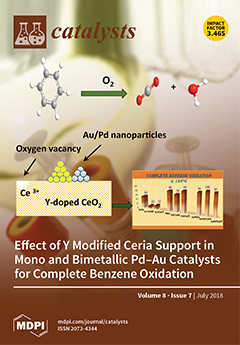Regeneration process and adsorbent performance were investigated by a fixed-bed adsorber at 300 °C. Surface species, zeolite structure, and Pt morphology were characterized by FT-IR, XRPD and EXAFS, respectively. Performance test results indicated that ethanol adsorption capacity of Pt/NaY-SiO
2 is about 2.5
[...] Read more.
Regeneration process and adsorbent performance were investigated by a fixed-bed adsorber at 300 °C. Surface species, zeolite structure, and Pt morphology were characterized by FT-IR, XRPD and EXAFS, respectively. Performance test results indicated that ethanol adsorption capacity of Pt/NaY-SiO
2 is about 2.5 times that of NaY-SiO
2. After regeneration, adsorption-capacity loss is 2.5 and 43%, respectively, for Pt/NaY-SiO
2 regenerated at superficial velocity of 13.2 (PtR
(HF)) and 5.3 cm/min (PtR
(LF)); in contrast, it is 8 and 21%, respectively, for NaYR
(HF) and NaYR
(LF). The appearance of absorption bands in the CH stretching region (υ
CH) of the IR spectra characterizing the regenerated NaY-SiO
2 suggested that the adsorption-capacity loss for NaY-SiO
2 was mainly caused by the deposition of carbonaceous species formed in regeneration, which cannot be burned off readily at 300 °C. In contrast, no υ
CH bands have been observed for the IR spectra of PtR
(HF) and PtR
(LF), indicating that Pt helps to burn off carbonaceous species. However, Pt agglomeration was observed in TEM and EXAFS for Pt/NaY-SiO
2(LF). The appearance of a υ
CO band at about 2085 cm
−1 of the IR spectra characterizing PtR
(LF) suggested that Pt agglomeration was induced by CO adsorption. The growth of Pt particles decreases the ethanol adsorbed on Pt together with the conversion of ethanol to ethoxides and aldehyde, leading to a decrease of adsorption capacity.
Full article





